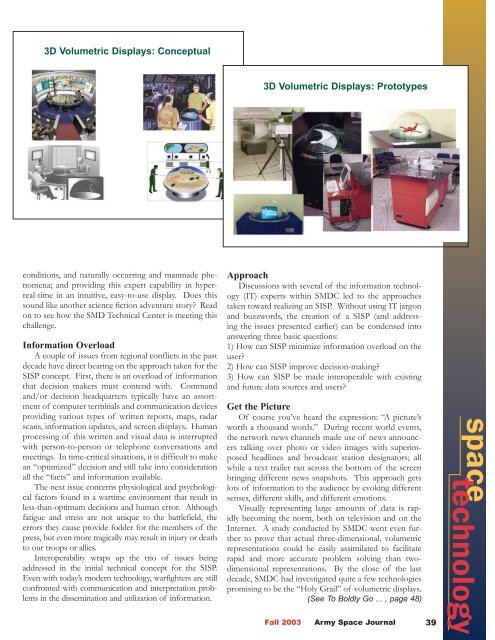Volume 2, Number 4 - Space and Missile Defense Command - U.S. ...
Volume 2, Number 4 - Space and Missile Defense Command - U.S. ...
Volume 2, Number 4 - Space and Missile Defense Command - U.S. ...
Create successful ePaper yourself
Turn your PDF publications into a flip-book with our unique Google optimized e-Paper software.
3D <strong>Volume</strong>tric Displays: Conceptual<br />
3D <strong>Volume</strong>tric Displays: Prototypes<br />
conditions, <strong>and</strong> naturally occurring <strong>and</strong> manmade phenomena;<br />
<strong>and</strong> providing this expert capability in hyperreal-time<br />
in an intuitive, easy-to-use display. Does this<br />
sound like another science fiction adventure story? Read<br />
on to see how the SMD Technical Center is meeting this<br />
challenge.<br />
Information Overload<br />
A couple of issues from regional conflicts in the past<br />
decade have direct bearing on the approach taken for the<br />
SISP concept. First, there is an overload of information<br />
that decision makers must contend with. Comm<strong>and</strong><br />
<strong>and</strong>/or decision headquarters typically have an assortment<br />
of computer terminals <strong>and</strong> communication devices<br />
providing various types of written reports, maps, radar<br />
scans, information updates, <strong>and</strong> screen displays. Human<br />
processing of this written <strong>and</strong> visual data is interrupted<br />
with person-to-person or telephone conversations <strong>and</strong><br />
meetings. In time-critical situations, it is difficult to make<br />
an “optimized” decision <strong>and</strong> still take into consideration<br />
all the “facts” <strong>and</strong> information available.<br />
The next issue concerns physiological <strong>and</strong> psychological<br />
factors found in a wartime environment that result in<br />
less-than-optimum decisions <strong>and</strong> human error. Although<br />
fatigue <strong>and</strong> stress are not unique to the battlefield, the<br />
errors they cause provide fodder for the members of the<br />
press, but even more tragically may result in injury or death<br />
to our troops or allies.<br />
Interoperability wraps up the trio of issues being<br />
addressed in the initial technical concept for the SISP.<br />
Even with today’s modern technology, warfighters are still<br />
confronted with communication <strong>and</strong> interpretation problems<br />
in the dissemination <strong>and</strong> utilization of information.<br />
Approach<br />
Discussions with several of the information technology<br />
(IT) experts within SMDC led to the approaches<br />
taken toward realizing an SISP. Without using IT jargon<br />
<strong>and</strong> buzzwords, the creation of a SISP (<strong>and</strong> addressing<br />
the issues presented earlier) can be condensed into<br />
answering three basic questions:<br />
1) How can SISP minimize information overload on the<br />
user?<br />
2) How can SISP improve decision-making?<br />
3) How can SISP be made interoperable with existing<br />
<strong>and</strong> future data sources <strong>and</strong> users?<br />
Get the Picture<br />
Of course you’ve heard the expression: “A picture’s<br />
worth a thous<strong>and</strong> words.” During recent world events,<br />
the network news channels made use of news announcers<br />
talking over photo or video images with superimposed<br />
headlines <strong>and</strong> broadcast station designators; all<br />
while a text trailer ran across the bottom of the screen<br />
bringing different news snapshots. This approach gets<br />
lots of information to the audience by evoking different<br />
senses, different skills, <strong>and</strong> different emotions.<br />
Visually representing large amounts of data is rapidly<br />
becoming the norm, both on television <strong>and</strong> on the<br />
Internet. A study conducted by SMDC went even further<br />
to prove that actual three-dimensional, volumetric<br />
representations could be easily assimilated to facilitate<br />
rapid <strong>and</strong> more accurate problem solving than twodimensional<br />
representations. By the close of the last<br />
decade, SMDC had investigated quite a few technologies<br />
promising to be the “Holy Grail” of volumetric displays.<br />
(See To Boldly Go ... , page 48)<br />
Fall 2003 Army <strong>Space</strong> Journal 39<br />
space technology

















